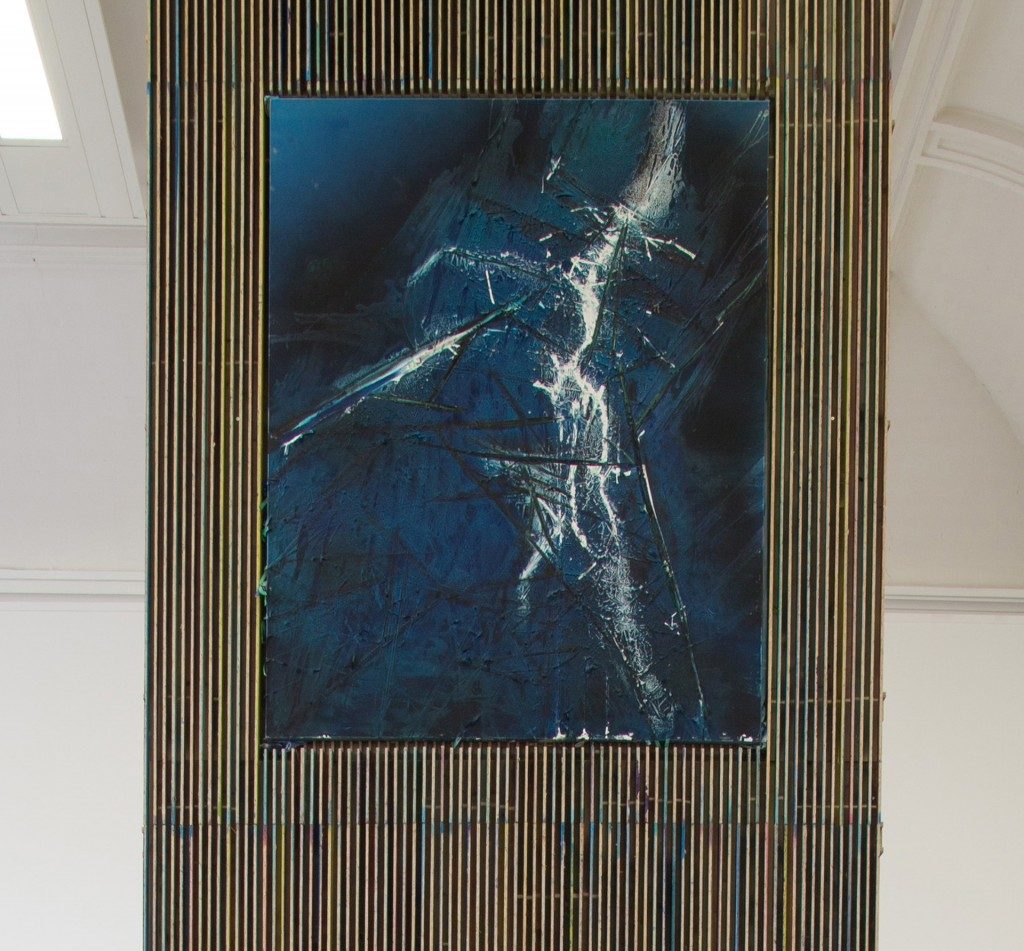Ruïne park tilburg
voor informatie scroll naar beneden








Ruine Park was a collaboration with Tim Breukers. Visitors had to physically interact with the installation (walk on and though it) to be able to see it. The installations of Tim (a styrofoam castle) and mine were both very large and attempted to fill the space of Park. In this attempt the works collided and created a ‘ruin’. The painting presented at seven meters high in the highest wall showed an electricity mast being struck by lightning.
The subjects I choose demand a specific way of presentation. In my thinking, making a painting and presenting it to the public are inseparable. A painting claims a certain way of viewing it, the medium requires a concentrated, longer, deeper look. This concentration has to be commanded, because our viewing habit has changed due to the current fleeting abundance of images in everyday life. In the excess of visually loud neon advertisements in the streets, for instance a poster draws attention when it’s contrasting its surroundings using a different mode of communication. I catch myself walking around in a museum with an attitude of a bored channel-surfing couch potato, slouched in front of the television. This is why I opt for radical presentations of my work, using the same tricks as the ‘smart’ commercials, to catch and direct the attention of the viewer.
My work needs to actively engage with the space where it is shown. For the series I can’t sing the blues in an air conditioned room (fig 6, 8 ,9 ,10) I build architectural constructions from wood, that are visually dominant, as a framework for paintings. The painting, placed in the center of the construction, remains unchanged though the construction surrounding it provides it with a different context than a conventional white wall. I oppose the laws of painting with elements taken from outside of the tradition of the medium. Usually the white wall behind a painting facilitates the viewers’ focus on the wall. My constructions however are like the white noise static of an old television. The optical interference facilitates an similar concentration, but in reverse: the painting in the center becomes the refuge for the eye. If the eye wanders beyond the boundaries of the painting frame, it meets the framework and is loses focus.
Next to gallery and museum spaces, additionally I use these constructions at locations that are not designed for presenting visual art, for example to turn a monumental former factory hall into my own exhibition space. Here, the wooden framework serves as the connecting element that links the work to the existing architecture (fig 8). In white-cube galleries and museums I replace the white walls, hijacking the space, taking charge of the environment in which my work is viewed.
NL
Het onderwerp draagt op tot een specifieke manier van presenteren. Schilderen en presenteren zijn in mijn denken niet gescheiden van elkaar. Een schilderij vereist een bepaalde manier van kijken, langer en dieper, Voor het medium is concentratie nodig. Die concentratie moet afgedwongen worden, want de vluchtigheid en alomtegenwoordigheid van beeld heeft ons kijkgedrag veranderd. In een overdaad aan schreeuwerige neonreclame op straat valt een reclameposter op, doordat de poster een andere communicatievorm hanteert die meer tot de verbeelding spreekt. Ik betrap mezelf erop dat ik in een museum rondloop als een verveelde, onderuitgezakte televisiekijker die aan het zappen is van kunstwerk tot kunstwerk. Ik kies daarom voor radicale manieren van presenteren die de aandacht van de kijker opeisen, op de manier van de sprekende reclameposter.
Mijn schilderijen moeten zich actief verhouden tot de ruimte waarin ze getoond worden. Voor de serie werken ‘I can’t sing the blues in an air conditioned room’ (fig) bouw ik dominante architectonische constructies van hout als omlijsting voor de schilderijen. Met het schilderij, middenin de constructie gemonteerd, is niets geks gedaan: het blijft een schilderij in de conditie waarin iedereen het als zodanig zal herkennen, maar de context is anders. Tegenover de wetmatigheden van een schilderij plaats ik een element wat zich buiten de traditie van het medium bevindt. Normaal gesproken faciliteert een witte wand de concentratie op een schilderij, mijn wand daarentegen ruist als een oude TV. De optisch interfererende wand creëert eenzelfde concentratie, maar nu juist andersom: het schilderij in het midden vormt een rustpunt voor het oog. Dwaal je af, buiten de grenzen van het schilderij, dan blijkt de omlijsting lastig om op te focussen. Deze constructies gebruik ik op plekken die niet bedoeld zijn voor de presentatie van beeldende kunst. Een monumentale fabriekshal wordt zodoende mijn tentoonstellingszaal en hierin functioneert mijn omlijstende wand of vloer als verbindend architectonisch element . In galeries en musea vervang ik de witte wanden (fig) en maak ik me de ruimte eigen met een nieuwe context waarin het werk bekeken dient te worden.
Tilburg PARK
LINKS:
trendbeheer


opening


Opbouw
Tim Breukers


















